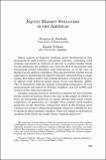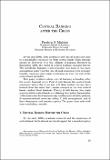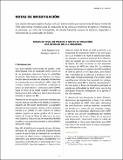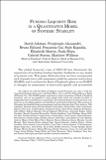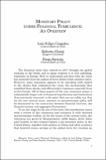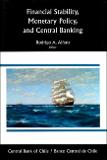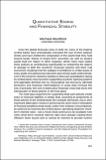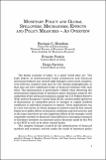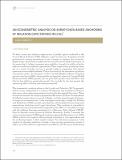Buscar
Mostrando ítems 1-10 de 34
Equity market spillovers in the Americas
Many aspects of financial markets merit monitoring in risk management and portfolio allocation contexts, including (and perhaps especially) in contexts of interest to central banks. Much recent attention, for example, has been devoted to measuring and forecasting return volatilities and correlations, ...
Central banking after the crisis
By the mid-2000s both academics and central banks had come to a remarkable consensus on what central banks’ basic strategy should be. However with the collapse of Lehman Brothers in September 2008 the world of central banking changed forever. The worldwide financial crisis revealed that some of the ...
Metas de nivel de precios y metas de inflación: una revisión de la literatura
Las autoridades monetarias de países tanto desarrollados como en desarrollo tienen, como uno de sus principales objetivos, lograr la estabilidad de precios. Para alcanzar este objetivo este logro, muchos bancos centrales han adoptado formalmente un esquema de metas de inflación (MI). Bajo MI, el banco ...
Funding liquidity risk in a quantitative model of systemic stability
The global financial crisis of 2007–09 has illustrated the importance of including funding liquidity feedbacks in any model of systemic risk. This paper illustrates how we have incorporated such channels into a risk assessment model for systemic institutions (RAMSI) and it outlines the Bank of England’s ...
Monetary policy under financial turbulence: an overview
The financial crisis that started in 2007 brought the global economy to the brink and in many respects it is still unfolding especially in Europe. How to understand and deal with the crisis has naturally been the subject of fierce debates that continue today. However some consensus appears to be ...
Monetary policy under financial turbulence
The financial crisis that started in 2007 brought the global economy to the brink, and in many respects it is still unfolding, especially in Europe. While a fierce debate continues on how to understand and deal with the crisis, a consensus is emerging with regard to the originating shocks, the mechanisms ...
Financial stability, monetary policy, and Central Banking
The financial developments of the last decade have had a large impact on the range of risk diversification contracts available to investors. Based on these complex instruments, the investment possibility frontier was shifted outward and increasingly intricate networks were created. At the same time, ...
Quantitative easing and financial stability
Since the global financial crisis of 2008–09 many of the leading central banks have dramatically increased the size of their balance sheets and have shifted the composition of the assets that they hold toward larger shares of longer-term securities (as well as toward assets that are riskier in other ...
Monetary policy and global spillovers: mechanisms effects and policy measures: an overview
The global economy of today 'is a small world after all.' The high degree of international trade integration and financial interconnectedness has created tight linkages across most countries even between countries that may be very distant geographically or that may not have significant trade or financial ...
An econometric analysis on survey-data-based anchoring of inflation expectations in Chile
To what extent are inflation expectations of public agents anchored to the Central Bank of Chile’s (CBC) inflation target? In this note, I perform several econometric testing procedures in an attempt to answer this question. Expectations’ anchoring is understood as another central bank instrument, in ...

